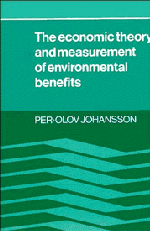Book contents
- Frontmatter
- Contents
- Preface
- 1 Introduction
- 2 Some basic concepts
- 3 The concept of consumer surplus
- 4 Topics in the theory of consumer surplus measures
- 5 Consumer surplus measures in quantity-constrained regimes
- 6 Public goods and externalities in consumption
- 7 How to overcome the problem of preference revelation; practical methodologies
- 8 Discrete choice models and environmental benefits
- 9 Consumer's surplus in an intertemporal context
- 10 Welfare change measures in a risky world
- 11 Money measures of the total value of environmental assets
- Notes
- Bibliography
- Index
11 - Money measures of the total value of environmental assets
Published online by Cambridge University Press: 10 January 2011
- Frontmatter
- Contents
- Preface
- 1 Introduction
- 2 Some basic concepts
- 3 The concept of consumer surplus
- 4 Topics in the theory of consumer surplus measures
- 5 Consumer surplus measures in quantity-constrained regimes
- 6 Public goods and externalities in consumption
- 7 How to overcome the problem of preference revelation; practical methodologies
- 8 Discrete choice models and environmental benefits
- 9 Consumer's surplus in an intertemporal context
- 10 Welfare change measures in a risky world
- 11 Money measures of the total value of environmental assets
- Notes
- Bibliography
- Index
Summary
A typical feature of many environmental resources is that they provide many different values. Following Boyle and Bishop (1985) one may distinguish between four more or less distinct values. First of all, there are consumptive use values such as fishing and hunting. Secondly, some resources provide non-consumptive use values. For example, some people enjoy bird watching, while others gain satisfaction from viewing wildlife. Thirdly, a resource may also provide services indirectly through books, movie pictures, television programmes, and so on. Finally people may derive satisfaction from the pure fact that a habitat or species exists.
In this chapter, the tools developed in the previous chapters are put together in an analysis of the total benefits of an environmental asset in a certain as well as in a risky world. Section 1 considers the total value of an environmental asset in a certain world. However, the future availability of a natural resource is frequently uncertain. Section 2 presents different willingness to pay measures that can be used to assess the value of having the supply of a resource stabilized at some arbitrary level. In some cases, a particular project may affect the random variations in the supply of an asset without achieving a certain future supply. Section 3 deals with this case, while Section 4 presents an empirical study concerned with many of the issues considered in this chapter.
- Type
- Chapter
- Information
- The Economic Theory and Measurement of Environmental Benefits , pp. 183 - 202Publisher: Cambridge University PressPrint publication year: 1987



